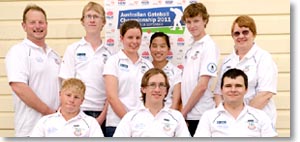

|
Back to |
| The Front Page |
| News & Features |

|
Gateball goes international |
|
by Alex Park photos by Josh McGhie from Jam Theater Photography Posted October 22, 2011
|
For decades, milllions have followed gateball tournaments on television in Japan, and the popular team sport is beginning to make inroads in Spanish-speaking countries. Now the fast-paced, scaled-down team sport has secured a strong English-language beachhead. Australia, under the enlightened banner of "mallet sports," is actively promoting the game's spread through their state associations, with gateball events scheduled for some of the main croquet venues. More than 150 players from Australia, China, and Japan competed in the 2011 Australian Gateball Championship under near-cloudless skies at the Newcastle National Park Croquet Club, about two hours north of Sydney. The seven teams on debut provide further evidence of the rapidly escalating growth of gateball in Australia.
2011 Australian Gateball Championship – Photo Story

|
| It's the most space-efficient of all the mallet sports. |
The major competitions in Australia are already larger than most croquet events, with plenty of space to multiply all the numbers on courts of regulation size much smaller than croquet half-courts. The numbers patterned on the grass reflect the team divisions: Team members play in numbered sequence, with the five odd-numbered players sequenced against the five even-numbered ones. Think of putting four gateball courts on each of your croquet courts, with ten players on each of the courts, and you begin to understand just how space-efficient this game is. Throw in the concept of the typical game-time of 30 minutes, and you have the capacity to design a respectable one-day gateball tournament on only one of your croquet lawns.

|
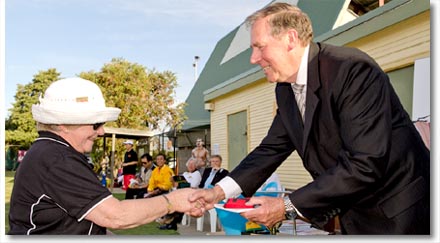
|
| Hoopla for the ceremonial opening. |
The tournament was opened with a traditional 'Welcome to Country' – a ceremony performed by Aboriginal or Torres Strait Islander people to welcome visitors to their traditional land. It also included the presentations of captains' armbands by the Mayor of Newcastle, Councillor John Tate, to representatives of each team. Finally, the state member of parliament for Newcastle, Mr. Tim Owen MP, hit a ball through the ceremonial first gate to declare the event open.
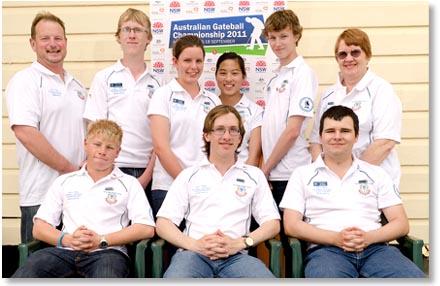
|
| TRAC Team |
High schoolers from Wagga Wagga impress in their first competition. One of the most popular teams at the championship was the high school team from the Riverina Anglican College in Wagga Wagga, New South Wales. The team started playing as recently as July 2011 - only two months before the championship - but trained up to four times a week to prepare for the event. They were supported by their local croquet club and visiting coaches from Canberra and the Blue Mountains, who gave them workshops most weekends leading up to the championship. The team put in an impressive showing at their first competition, including a narrow one-point loss against a top-flight team from Japan. The team attracted a lot of media attention in their home town, and have declared their intention to continue to develop their competitive gateball program.
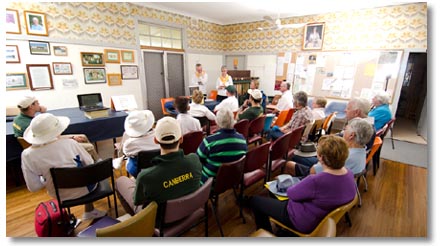
|
| Schools workshop |
Gateball's further expansion in the schools is strategised. During the official practice day at the start of the event, players also met to discuss strategies for promoting gateball in schools. Several players outlined the programs they run with schools in their local area. Representatives from the Riverina Anglican College spoke about why they enjoyed the game and suggested ways to approach future expansion.

|
| Sparks fly! |
Spectators at gateball tournaments never tire of watching players "spark," when it's legal to ‘bombard’ out an opponent’s ball. ("Sparking" is the equivalent of the "croquet stroke" and reminiscent of "sending the ball" as played in nine-wicket or garden croquet in English-speaking countries.) Teammates are allowed to help line up their colleagues’ sparks.
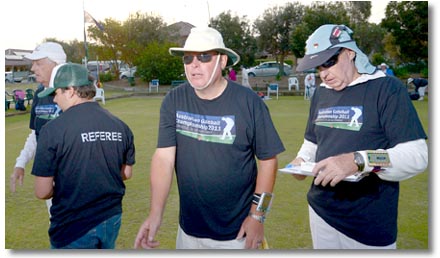
|
| All teams helped out with the refereeing. |
When they weren’t playing games, teams were rostered to officiate other matches. Two of Australia’s top-level referees were in charge of the grand final, assisted by a recorder and a young linesman from the Wagga Wagga school team.

|
| China teams dominate the sport and this championship. |
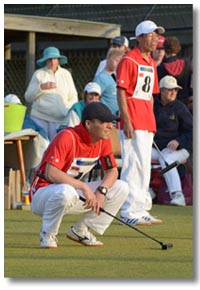
|
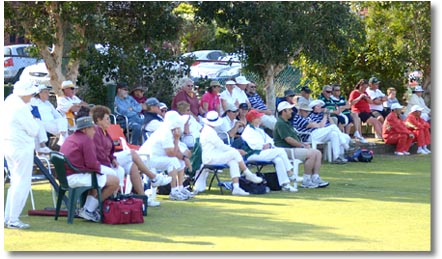
|
| A crowd of more than one hundred watch the finals. |
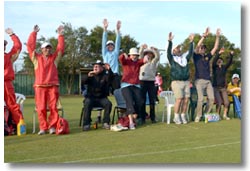
|
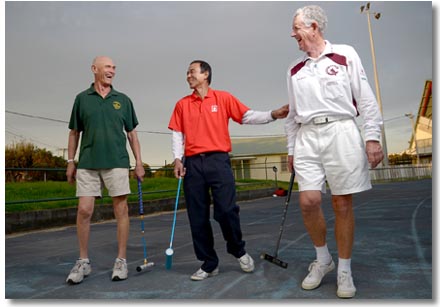
|
| 'God fathers of gateball’ in Australia are recognised. |

|
| Sponsors were the Australia-Japan Foundation and the New South Wales Government. |
The size and international character of this event attracted significant sponsorship from the Australian Government, through the Australia-Japan Foundation; and from the New South Wales Government, through an international sports event grant.
|
Riverina Anglican College Plays Gateball by Rebekah Lai They had only eight weeks to train, but they were determined to enter the 2011 Australian Gateball Championship. The team members were all year 10 and 11 students from the Riverina Anglican College (TRAC). Their remarkable play on such short notice included losing by only a single point to a top Japanese team.
They were the youngest team to enter the competition. They played against teams from not only Australia, but also China and Japan. The team - the first-ever high school team to enter a national gateball championship - quickly created the strongest buzz throughout the competition, with their energy, enthusiasm, and inspired play. Everyone wanted to watch them compete. During the quarter finals, the TRAC team attempted to play a friendly match to pass time, but were asked not to do so. It was feared the crowd watching the quarter finals might move away just to watch the new team of youngsters play! "The team performed exceptionally well," commented Ian Begg. "The seven kids reflected more than just themselves: they reflected the community behind gateball. The support given from families, friends, from Canberra and the Blue Mountains were amazing. These are definitely memories we will carry throughout our lifetime." The team is considering entering another gateball competition before the end of the year. |
These photos of the 2011 Australian Gateball Championship were taken by the official tournament photographer, Josh McGhie from Jam Theater photography. His team photos were presented as gifts during the closing ceremony.
